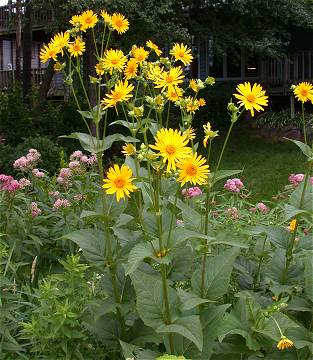

Silphium perfoliatum - (image 1 of 6)
Taxonomy
Family: Asteraceae
Habitat
Floodplains near streams. Calcareous springy places. Woods and low ground.
Associates
Near streams with Acer negundo, Acer saccharinum, Actinomeris alternifolia, Ambrosia trifida, Asarum canadense, Campanula americana, Celtis occidentalis, Cryptotaenia canadensis, Elymus virginicus, Fraxinus americana, Galium aparine, Geum canadense, Hydrophyllum virginianum, Laportea canadensis, Lysimachia ciliata, Osmorhiza longistylis, Ranunculus septentrionalis, Rhus radicans, Rudbeckia laciniata, Sambucus canadensis, Sanicula gregaria, Ulmus americana, Urtica procera, Viola sororia, Zizia aurea. In calcareous springy places with Anemone canadensis, Angelica atropurpurea, Apios americana, Equisetum arvense, Eupatorium maculatum, Impatiens capensis, Solidago patula, Symplocarpus foetidus.
Distribution
Southern Ontario west to ND, south to NC, MI, LA, and OK. Introduced to New England.
Morphology
Coarse, herbaceous perennial, to 12' high. Stems quadrangular. Leaves connate-perfoliate, the blade deltoid to ovate, coarsely toothed, to 6" long. Heads in an open inflorescence, the disk to 1" wide; involucral bracts elliptic or ovate; rays yellow, to 4 cm long. Fruit an achene.
Notes
Flowers early June to early September
Wetland indicator: Upland
This species has been investigated as a possible forage plant for its high nutritional value and low fiber content. Makes an excellent centerpiece in a garden setting, space allowing.
References
Gleason, Henry A. and A. Cronquist. 1991. Manual of Vascular Plants of
Northeastern United States
and Adjacent Canada. Second Ed.
The New York Botanical Garden. Bronx, NY
Swink, F. and G. Wilhelm. 1994. Plants of the Chicago Region.
Indiana Academy of Science. The Morton Arboretum. Lisle, Illinois.
|
Michael Hough © 2005 |